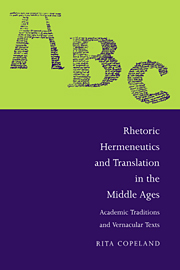Book contents
- Frontmatter
- Contents
- Acknowledgments
- List of abbreviations
- Introduction
- 1 Roman theories of translation: the fusion of grammar and rhetoric
- 2 From antiquity to the Middle Ages I: the place of translation and the value of hermeneutics
- 3 The rhetorical character of academic commentary
- 4 Translation and interlingual commentary: Notker of St. Gall and the Ovide moralisé
- 5 Translation and intralingual reception: French and English traditions of Boethius' Consolatio
- 6 From antiquity to the Middle Ages II: rhetorical invention as hermeneutical performance
- 7 Translation as rhetorical invention: Chaucer and Gower
- Afterword
- Notes
- Bibliography
- 1 Index of names and titles
- 2 General index
7 - Translation as rhetorical invention: Chaucer and Gower
Published online by Cambridge University Press: 03 December 2009
- Frontmatter
- Contents
- Acknowledgments
- List of abbreviations
- Introduction
- 1 Roman theories of translation: the fusion of grammar and rhetoric
- 2 From antiquity to the Middle Ages I: the place of translation and the value of hermeneutics
- 3 The rhetorical character of academic commentary
- 4 Translation and interlingual commentary: Notker of St. Gall and the Ovide moralisé
- 5 Translation and intralingual reception: French and English traditions of Boethius' Consolatio
- 6 From antiquity to the Middle Ages II: rhetorical invention as hermeneutical performance
- 7 Translation as rhetorical invention: Chaucer and Gower
- Afterword
- Notes
- Bibliography
- 1 Index of names and titles
- 2 General index
Summary
Augustine and his heirs, the “preceptive grammarians,” restore rhetoric to a powerful discursive role by’ identifying invention with the activity of exegesis, the modus inveniendi with the modus interpretandi. Augustine achieves this by giving rhetorical control over to readers, empowering readers to make the text meaningful. Matthew of Vendôme and Geoffrey of Vinsauf take this further by locating the topics of rhetorical invention in textual communis materia. In this revaluation of rhetoric, hermeneutics is still the dominant force: rhetoric assumes an ascendent role only when it is defined in terms of the governing framework of hermeneutics, that is, when it is defined as hermeneutical performance.
This definition of rhetorical invention has important implications for vernacular translation, and ultimately for the status of translation as a form of academic discourse in the vernacular. If invention can be understood as a hermeneutical performance on a traditional textual source, this model of invention can also extend to certain forms of vernacular exegetical translation. For the tradition of academic translation that we have traced here, hermeneutics is also the dominant and defining force. But certain products of this tradition develop the contestative or rhetorical motive of exegesis to such an extent that their exegetical service becomes full-fledged rhetorical appropriation. Such texts constitute what I have called “secondary translation.” In the following discussion I will examine the character of secondary translation by considering two English texts which redefine the terms of academic discourse in the vernacular: Chaucer's Legend of Good Women and Gower's Confessio amantis. These texts carry out the prescriptions of the artes poetriae by turning the techniques of exegesis into techniques of topical invention.
- Type
- Chapter
- Information
- Rhetoric, Hermeneutics, and Translation in the Middle AgesAcademic Traditions and Vernacular Texts, pp. 179 - 220Publisher: Cambridge University PressPrint publication year: 1991



